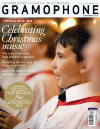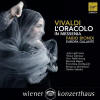Texte paru dans: / Appeared in:
*

GRAMOPHONE (12/2012)
Pour s'abonner /
Subscription information
Virgin
6025472

5099960254726 (ID245)
Reviewer: David Vickers
Biondi’s reconstruction of Vivaldi
Messenia pasticcio
This might seem like yet another unfamiliar Vivaldi opera
uncovered but the truth is more complicated. Giacomelli’s setting of Zeno’s
libretto La Merope (derived from a tragedy by Euripedes) was
performed at Venice’s Teatro S Giovanni Gristostomo during the 1734
Carnival. Four years later Vivaldi presented his own version, retitled
L’oracolo in Messenia, across town at the Teatro S Angelo. This pasticcio
featured music by Giacomelli, Vivaldi and probably others but only the
printed libretto survives. Vivaldi was hoping to produce a revival in Vienna
when he died there in 1741 and a performance took place posthumously at the
Kärntnertortheater during the 1742 Carnival. Agan, only the libretto
survives — and it is not the same as the Venetian ‘original’ but suggests
that Vivaldi revised the piece before his death. This recording presents
Fabio Biondi’s reconstruction of the posthumous Viennese pasticcio, recorded
appropriately enough in Vienna’s Konzerthaus.
The Sinfonia (from Griselda) typifies
the vibrant élan which we have come to expect from Europa Galante: cracking fast
music that packs a horn-fuelled punch surrounding a slow central movement played
with a juxtaposition of delicacy and muscle. Biondi draws 10 arias from
Vivaldi’s Atenaide, Catone in Utica, Motezuma, Dorilla
in Tempe, Farnace and Semiramide which are readily
transferrable to their new dramatic contexts. ‘Se al cader del rnostro orrendo’
(from Motezuma) strikingly insinuates that the villain Polifonte is
making promises he clearly has no intention of keeping (it transpires he ordered
the murder of Merope’s husband and most of her children, and now wants to marry
her). Thirteen numbers from Giacomelli’s La Merope include two that
Vivaldi had already used in Bajazet and most are impressive evidence of
Giacomelli’s qualities: the hero Epitide’s ‘Dono d’amica sotte’ shows off Vivica
Genaux’s voice to full advantage; the noble Licisco’s brightly optimistic
‘Sinché il tiranno scendere’ is sung elegantly by Franziska Gottwald. We also
hear the famous Farinelli showpiece ‘Son qual nave’ from Broschi’s Artaserse
(sung magnificently by Julia Lezhneva’s anxious Trasimede). Licisco’s
‘Nell’orror di notre oscura’ from Hasse’s Siroe is a flamboyant highlight
of the final act but the opera’s explosive dramatic climax is Ann Hallenberg’s
incisive performance of Giacomelli’s intense scene for Merope when she
believes her long-lost sole surviving son has just been brutally assassinated.
It turns out that this zesty performance reveals a valuable examination of
Giacomelli.
Fermer la fenêtre/Close window
Cliquez l'un ou l'autre
bouton pour découvrir bien d'autres critiques de CD
Click either button for many other reviews


